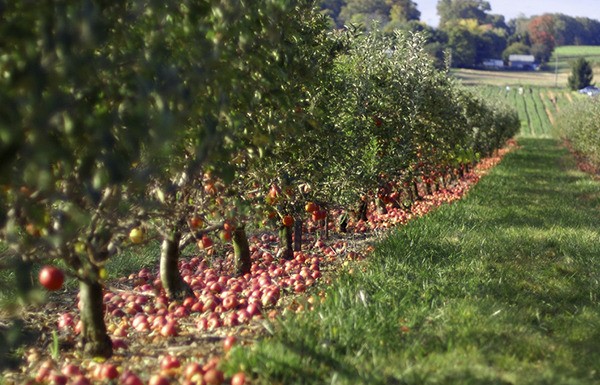Whether you have space for dozens of trees or only a few, having your own apple orchard is a treat. Select a level site with good drainage and where irrigation can be established.
Apple trees prefer full sunlight and morning sun is very important. Moisture that collects on leaves during the night is dried by early morning sunlight reducing the opportunity for fungal growth.
Adequate air circulation also helps to reduce the occurrence of fungal disease.
When planning your orchard, allow ample room between trees to accommodate tree growth and the use of pushcart, tractor, limb supports, ladders and other equipment. Dwarf apple trees should be planted a minimum of 8-14 feet apart and semi-dwarf 15-20 feet apart.
The rootstock used when grafting apple trees determines the height of the tree so nearly all varieties of apples are available as dwarf, semi-dwarf and full-sized trees.
Many people grow dwarf and semi-dwarf trees because full-size trees require a large amount of space and are much more difficult to maintain and the fruit more difficult to pick because of the height of the tree.
When deciding which apples to plant, select varieties you like to eat and varieties that grow and produce well in your local area. Keep in mind that an apple that grows well in Eastern Washington or on the East Coast may not do well on the Olympic Peninsula.
Contact your local county Extension Office or orchard society for recommendations.
Even if you select a “self-fertile” variety, cross-pollination by another variety produces a better crop. Some apples have sterile pollen and cannot be used as a pollinator for itself or another variety. If you select an apple variety with sterile pollen, you will need two other varieties that are not pollen sterile.
To ensure good cross-pollination, select varieties that bloom at the same time.
Avoiding disease
Disease resistance also should be considered when selecting varieties.
Powdery mildew and apple scab are common apple diseases in the Pacific Northwest because of the moist climate. Disease resistant varieties, sunlight, good air circulation and well-maintained trees and orchard site all contribute to a healthy and productive home orchard.
Fall is the best time to plant your orchard. Remove the grass from the orchard area. Unless the soil is exceptionally full of stones, it should be ripped (dug up) 1.5-2 feet deep, in two directions.
Ripping will mix the soil, improve potential root penetration and identify buried tree roots and boulders that should be removed.
Soil samples
Have a soil test done at the Clallam Conservation District. Orchard soil should be between 6.2 and 7.2. If pH is lower than that, agricultural lime should be applied. When the soil is ripped prior to planting, the lime will mix with the low pH soil, react with the acid and rapidly improve the pH. If the soil test indicates your soil is low in magnesium, dolomitic lime should be applied.
If your soil test indicates a general problem with low nutrient levels, such as phosphorus and potassium, this is the most effective time to apply appropriate rates.
If you are unable to rip the soil before planting, dig a hole the depth of the root ball and two or three times as large in diameter.
Holding the tree in place in the hole, add water. Continue to refill the hole with soil, mounding the soil around the tree above the soil level. The graft union must be placed at least a hand-width (4-6 inches) above the soil mound so that it will be above the soil level when the planting soil in the planting hole has finished slumping. The bud union of the tree always should remain above the soil level.
Add a stake adjacent to the newly planted trees to provide support. Fence the orchard to protect it from grazing deer and elk. If rabbits are a problem in your area, add a finer mesh material along the lower 2 feet of the fence.
Water regularly to help the tree establish a strong root system.
Online help
The Pacific Northwest Extension Publication PNW 400 “Training and Pruning Your Home Orchard” by R.L. Stebbins, available online, is a valuable guide to caring for your home orchard.
Judy English is a Washington State University-certified Clallam County Master Gardener.



